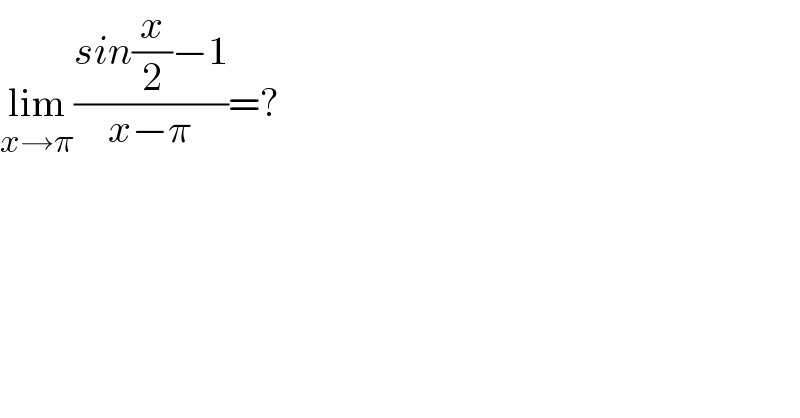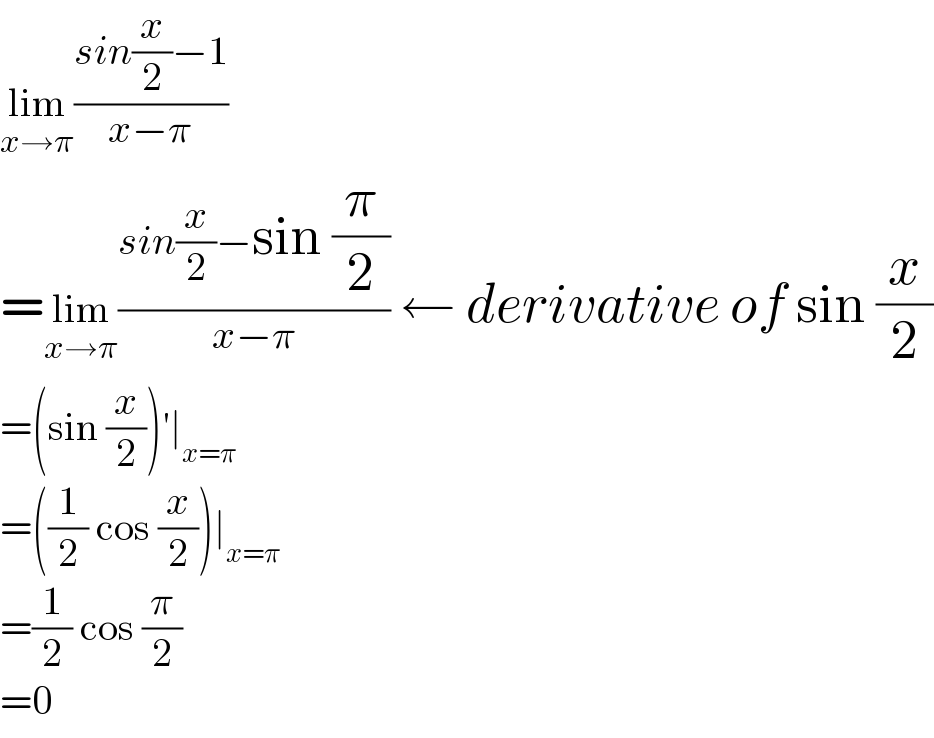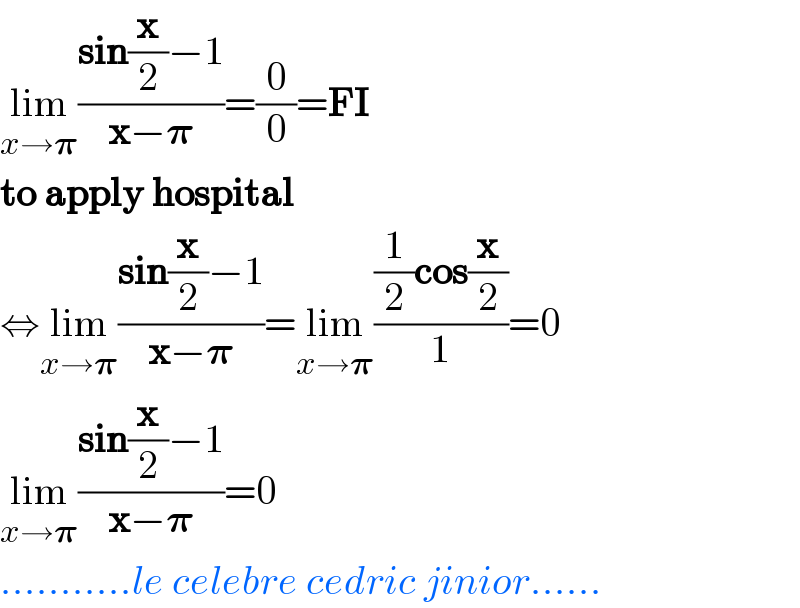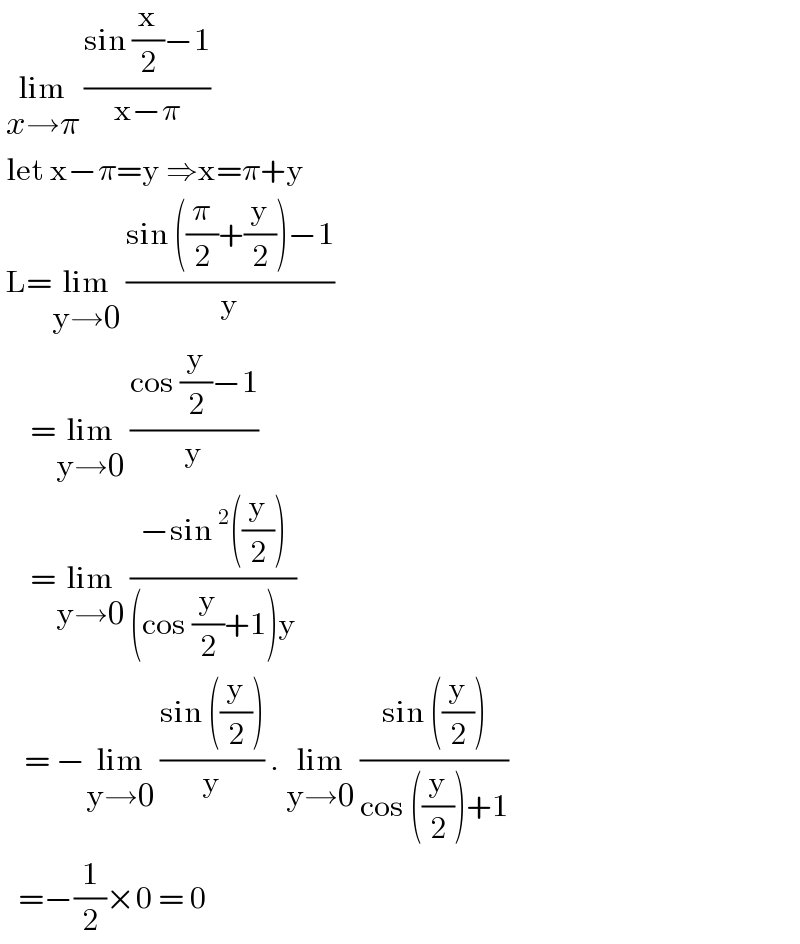
Question Number 179366 by mathlove last updated on 28/Oct/22

$$\underset{{x}\rightarrow\pi} {\mathrm{lim}}\frac{{sin}\frac{{x}}{\mathrm{2}}−\mathrm{1}}{{x}−\pi}=? \\ $$
Commented by mahdipoor last updated on 28/Oct/22

$$={D}_{{x}} \left({sin}\frac{{x}}{\mathrm{2}}\right)_{{x}=\pi} =\frac{\mathrm{1}}{\mathrm{2}}{cos}\left(\frac{{x}}{\mathrm{2}}\right)_{{x}=\pi} =\mathrm{0} \\ $$
Commented by mathlove last updated on 28/Oct/22

$${discraib}\:{answer}?? \\ $$
Commented by mr W last updated on 29/Oct/22

$$\underset{{x}\rightarrow\pi} {\mathrm{lim}}\frac{{sin}\frac{{x}}{\mathrm{2}}−\mathrm{1}}{{x}−\pi} \\ $$$$=\underset{{x}\rightarrow\pi} {\mathrm{lim}}\frac{{sin}\frac{{x}}{\mathrm{2}}−\mathrm{sin}\:\frac{\pi}{\mathrm{2}}}{{x}−\pi}\:\leftarrow\:{derivative}\:{of}\:\mathrm{sin}\:\frac{{x}}{\mathrm{2}} \\ $$$$=\left(\mathrm{sin}\:\frac{{x}}{\mathrm{2}}\right)'\mid_{{x}=\pi} \\ $$$$=\left(\frac{\mathrm{1}}{\mathrm{2}}\:\mathrm{cos}\:\frac{{x}}{\mathrm{2}}\right)\mid_{{x}=\pi} \\ $$$$=\frac{\mathrm{1}}{\mathrm{2}}\:\mathrm{cos}\:\frac{\pi}{\mathrm{2}} \\ $$$$=\mathrm{0} \\ $$
Commented by mathlove last updated on 29/Oct/22

$${tanks} \\ $$
Commented by CElcedricjunior last updated on 29/Oct/22

$$\underset{{x}\rightarrow\boldsymbol{\pi}} {\mathrm{lim}}\frac{\boldsymbol{\mathrm{sin}}\frac{\boldsymbol{\mathrm{x}}}{\mathrm{2}}−\mathrm{1}}{\boldsymbol{\mathrm{x}}−\boldsymbol{\pi}}=\frac{\mathrm{0}}{\mathrm{0}}=\boldsymbol{\mathrm{FI}} \\ $$$$\boldsymbol{\mathrm{to}}\:\boldsymbol{\mathrm{apply}}\:\boldsymbol{\mathrm{hospital}}\: \\ $$$$\Leftrightarrow\underset{{x}\rightarrow\boldsymbol{\pi}} {\mathrm{lim}}\frac{\boldsymbol{\mathrm{sin}}\frac{\boldsymbol{\mathrm{x}}}{\mathrm{2}}−\mathrm{1}}{\boldsymbol{\mathrm{x}}−\boldsymbol{\pi}}=\underset{{x}\rightarrow\boldsymbol{\pi}} {\mathrm{lim}}\frac{\frac{\mathrm{1}}{\mathrm{2}}\boldsymbol{\mathrm{cos}}\frac{\boldsymbol{\mathrm{x}}}{\mathrm{2}}}{\mathrm{1}}=\mathrm{0} \\ $$$$\underset{{x}\rightarrow\boldsymbol{\pi}} {\mathrm{lim}}\frac{\boldsymbol{\mathrm{sin}}\frac{\boldsymbol{\mathrm{x}}}{\mathrm{2}}−\mathrm{1}}{\boldsymbol{\mathrm{x}}−\boldsymbol{\pi}}=\mathrm{0} \\ $$$$...........{le}\:{celebre}\:{cedric}\:{jinior}...... \\ $$
Answered by a.lgnaoui last updated on 28/Oct/22

$$\mathrm{lim}_{\mathrm{x}\rightarrow\pi} \frac{\mathrm{1}}{\mathrm{2}}×\left(\frac{\mathrm{sin}\:\frac{{x}}{\mathrm{2}}−\mathrm{sin}\:\frac{\pi}{\mathrm{2}}}{\frac{{x}}{\mathrm{2}}−\frac{\pi}{\mathrm{2}}}\right)=\frac{\mathrm{1}}{\mathrm{2}}×\frac{{d}\left(\mathrm{sin}\:\frac{{x}}{\mathrm{2}}\right)_{{x}=\pi/\mathrm{2}} }{{dx}}=\frac{\mathrm{1}}{\mathrm{4}}\mathrm{cos}\left(\:\frac{\pi}{\mathrm{4}}\:\right)=\frac{\mathrm{1}}{\mathrm{4}}×\frac{\sqrt{\mathrm{2}}}{\mathrm{2}}=\frac{\sqrt{\mathrm{2}}}{\mathrm{8}} \\ $$
Commented by Acem last updated on 29/Oct/22

$${fix}\:\left(\mathrm{sin}\:\theta\right)' \\ $$
Answered by cortano1 last updated on 29/Oct/22

$$\:\underset{{x}\rightarrow\pi} {\mathrm{lim}}\:\frac{\mathrm{sin}\:\frac{\mathrm{x}}{\mathrm{2}}−\mathrm{1}}{\mathrm{x}−\pi}\: \\ $$$$\:\mathrm{let}\:\mathrm{x}−\pi=\mathrm{y}\:\Rightarrow\mathrm{x}=\pi+\mathrm{y} \\ $$$$\:\mathrm{L}=\underset{\mathrm{y}\rightarrow\mathrm{0}} {\mathrm{lim}}\:\frac{\mathrm{sin}\:\left(\frac{\pi}{\mathrm{2}}+\frac{\mathrm{y}}{\mathrm{2}}\right)−\mathrm{1}}{\mathrm{y}} \\ $$$$\:\:\:\:\:=\underset{\mathrm{y}\rightarrow\mathrm{0}} {\mathrm{lim}}\:\frac{\mathrm{cos}\:\frac{\mathrm{y}}{\mathrm{2}}−\mathrm{1}}{\mathrm{y}} \\ $$$$\:\:\:\:\:=\underset{\mathrm{y}\rightarrow\mathrm{0}} {\mathrm{lim}}\:\frac{−\mathrm{sin}\:^{\mathrm{2}} \left(\frac{\mathrm{y}}{\mathrm{2}}\right)}{\left(\mathrm{cos}\:\frac{\mathrm{y}}{\mathrm{2}}+\mathrm{1}\right)\mathrm{y}} \\ $$$$\:\:\:\:=\:−\underset{\mathrm{y}\rightarrow\mathrm{0}} {\mathrm{lim}}\:\frac{\mathrm{sin}\:\left(\frac{\mathrm{y}}{\mathrm{2}}\right)}{\mathrm{y}}\:.\:\underset{\mathrm{y}\rightarrow\mathrm{0}} {\mathrm{lim}}\:\frac{\mathrm{sin}\:\left(\frac{\mathrm{y}}{\mathrm{2}}\right)}{\mathrm{cos}\:\left(\frac{\mathrm{y}}{\mathrm{2}}\right)+\mathrm{1}} \\ $$$$\:\:\:=−\frac{\mathrm{1}}{\mathrm{2}}×\mathrm{0}\:=\:\mathrm{0} \\ $$
Commented by mathlove last updated on 29/Oct/22

$${thanks} \\ $$
